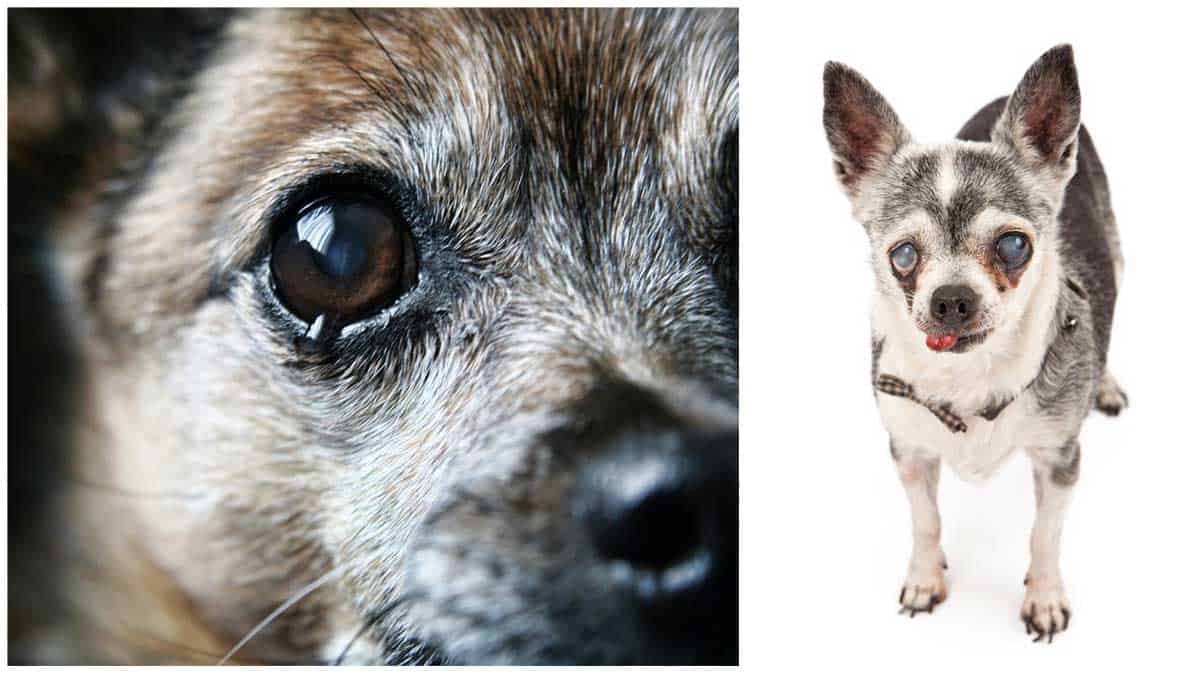For Chihuahuas, eye problems can be a significant cause of concern. After all, while they are a relatively healthy dog breed, their protruding eyes and proximity to the ground put them at high risk for eye problems and infections. The following examines the most common eye problems in Chihuahuas and the causes and treatment options.
Dry Eyes – Kerato Conjunctivitis Sicca
This is a common eye issue that is caused by a significant lack of tear production in either one or both eyes. It is most often seen in Chihuahuas over the age of 6, though this isn’t always the case. It may be the result of a genetic defect, viral infection, hypothyroidism, or aging. Symptoms include:
- Eyes that have a dull appearance or are red and irritated
- Constant blinking
- Eyes that are sticky and/ or are hard to blink after waking up
- Eye discharge that is thick and green
If your veterinarian determines your Chihuahua is suffering from dry eye, he or she will likely order eye lubricating drop or medication designed to stimulate tear production. In addition, you can gently wipe your Chihuahua’s eyes with a warm washcloth several times a day, especially after they have woken up. While it may not seem like a serious condition, dry eyes do have the potential to cause permanent damage or blindness if left untreated.

Foreign Object in Eye
Along with dry eyes, this is the most eye problem seen in Chihuahuas. This can be something as small as a speck of dust, sand, or grass. Signs that your Chihuahua may have something in his eyes include:
- Excessive tearing
- Pawing/ rubbing at the eye
- Rubbing his face on the ground
- Squinting
- Swelling of the eye or eyelid
If this is something small, you may be able to use a saline solution to flush the object out of his eye. If flushing is ineffective, you will need to go to the vet immediately, where they have both the proper training and equipment to safely remove the object.
Corneal Endothelial Dystrophy

Usually caused by the type of breed, aging, or inflammation of the uvea (the eye’s middle layer), corneal endothelial dystrophy occurs when not enough fluid is getting to the cornea (the eye’s outer layer), which leaves it dehydrated and causes the cornea to take on a bluish haze. This hazy color tends to be the first indication of a problem, though if it is allowed to progress, your Chihuahua may also exhibit some visual impairment.
If your dog suffers from this eye condition and the vet determines he needs treatment, a topical hyperosmotic agent that draws fluid out of the eye and reduces intraocular pressure, will most likely be prescribed, though in some cases no treatment is needed. This is a life-long condition and tends to be especially severe in Chihuahuas.
Corneal Ulcer
Most often the result of any trauma to the eye, such as a scratch, puncture, or abrasion, or a foreign object in the eye, corneal ulcers are common in all breeds of dogs and cats. Most ulcers only involve the top layer of the cornea and are considered superficial. Deeper ulcers that involve other layers of the cornea are more severe. Symptoms of a corneal ulcer include:
- Runny eyes
- A noticeable film over the eye, a red and inflamed appearance, or discharge from the eye
- Your pet may try to keep the affected eye closed
Treatment usually includes topical antibiotics, medications that control eye muscle spasms, and pain medication. If your Chihuahua continues to paw at his eye, he may be fitted with a neck collar. Thankfully, they usually heal in less than a week.
Lens Luxation
Though it is not very common, lens luxation is an eye condition you should be familiar with.
It involves the displacement or dislocation of the lens within the eye and is usually the result of eye trauma, congenital lens deformities, or glaucoma, though sometimes there is no known cause. Symptoms include:
- The eye suddenly becoming white
- Pain, squinting, increased tearing
Treatment is dependent on the location of the lens and the potential for vision. Typically, this includes surgically removing the lens and lowering the pressure within the eye. In severe cases, the removal of the entire eye may be necessary.
Cataracts
Cataracts usually happen when a dog gets older. It causes the dog’s pupil to become cloudy and whitish and the dog’s vision will worsen over time, eventually causing blindness. Surgery is the treatment of this condition.
Glaucoma
Dogs with glaucoma often become blind from the condition. It is caused by pressure on the optic nerve by a fluid buildup. It can also cause headaches for the dog. Surgery is usually the treatment for this; sometimes the eye must be removed.
Cherry Eye
Cherry eye is the prolapsed gland of the 3rd eyelid. It causes no pain or vision loss but it does look odd. It can be cured by a steroid ointment but if that doesn’t work, then surgery is recommended.
This is just a look at some of the eye problems Chihuahuas frequently experience. Keep in mind that the preceding information is meant to be informative and should not be used in lieu of a visit to the veterinarian. If your dog is having eye problems, please get them checked out by your vet.
Source: ilovemychi




